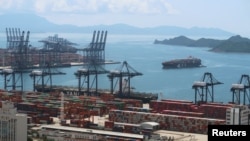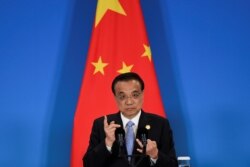Chinese leaders are expected to begin charting out a new economic development plan Friday as part of major meetings of top officials in Beijing.
The annual “Two Sessions” meetings, considered among the most important political events for top lawmakers and political advisers, are likely to result in major adjustments to the country’s economic goals.
Observers also are waiting to see if Chinese Premier Li Keqiang will announce the country’s GDP growth targets in the report that sets the tone for economic development throughout the year.
Already, the economic toll from the COVID-19 pandemic has forced major changes to national goals. Chinese officials had previously highlighted 2020 as the year when officials vowed to complete building a “moderately prosperous society,” when the gross national product and average income per capita would be double what it was in 2010.
That target is likely already a fantasy, after the economy reportedly contracted 6.8% this year compared with the first quarter of 2019. The International Monetary Fund estimated the Chinese economy could expand 1% to 1.5% in 2020.
Nicholas Lardy, an expert on China’s economy at Peterson Institute for International Economics, said the 2020 target will still likely be fulfilled within the next year.
“This is an objective set forth quite a few years ago, and maybe it's going to take them an extra six months to get there,” Lardy said.
Li Keqiang earlier said that as long as China can keep unemployment under control this year, it does not matter if it has a higher or lower annual growth rate.
Private companies? State owned?
One major dilemma for Chinese authorities for years has been how to encourage more private companies and shrink inefficient state-owned enterprises. That is expected to remain a key issue, even though it’s not on the Two Sessions agenda this year.
Beijing has said it would open up more sectors to private firms and reduce direct government interference in microeconomic activities. In the newly released plan for economic structural reform, Beijing tries to highlight a mixed ownership.
Lardy said that Beijing had been pursuing mixed ownership since 1995 when they passed the new corporate law, and mixed ownership has preceded fairly broadly within the state-owned enterprise sector. But, according to Lardy, the performance of state companies has basically been going down for 10 years.
“So, maybe they're going to implement it in a different way, or they're going to have different things. But, that's an example of something that I did not find so impressive because I think doubling down on mixed ownership, I don't see any reason to think it's going to be transformative,” Lardy said.
The National People’s Congress, delayed from early March because of the coronavirus outbreak, will start on May 22. The Chinese People’s Political Consultative Conference will start one day earlier on May 21.










